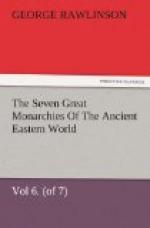On the north-east was Margiana, sometimes regarded as a country by itself, sometimes reckoned a mere district of Bactria. This was the tract of fertile land upon the Murg-ab, or ancient Margus river, which is known among moderns as the district of Merv. The Murg-ab is a stream flowing from the range of the Paropamisus, in a direction which is a little east of north; it debouches from the mountains in about lat. 36 deg. 25’, and thence makes its way through the desert. Before it reaches Merv, it is eighty yards wide and five feet deep, thus carrying a vast body of water. By a judicious use of dykes and canals, this fertilizing fluid was in ancient times carried to a distance of more than twenty-five miles from the natural course of the river; and by these means an oasis was created with a circumference of above 170, and consequently a diameter of above fifty miles. This tract, inclosed on every side by deserts, was among the most fertile of all known regions; it was especially famous for its vines, which grew to such a size that a single man could not encircle their stems with his two arms, and bore clusters that were a yard long. Margiana possessed, however, as a separate country, little military strength, and it was only as a portion of some larger and more populous territory that it could become formidable to the Parthians.
South of Margiana, and adjoining upon Parthia toward the east, was Aria, the tract which lies about the modern Herat. This was for the most part a mountain region, very similar in its general character to the mountainous portion of Parthia, but of much smaller dimensions. Its people were fairly warlike; but the Parthian population was probably double or triple their number, and Parthia consequently had but little to fear in this quarter.
Upon the south-east Parthia was bordered by Sarangia, the country of the Sarangae, or Drangae. This appears to have been the district south of the Herat valley, reaching thence as far as the Hamoon, or Sea of Seistan. It is a country of hills and downs, watered by a number of somewhat scanty streams, which flow south-westward from the Paropamisus to the Hamoon. Its population can never have been great, and they were at no time aggressive or enterprising, so that on this side also the Parthians were secure, and had to deal with no formidable neighbor.
Sagartia succeeded to Sarangia towards the west, and bordered Parthia along almost the whole of its southern frontier. Excepting in the vicinity of Tebbes and Toun (lat. 34 deg., long. 56 deg. to 58 deg.), this district is an absolute desert, the haunt of the gazelle and the wild ass, dry, saline, and totally devoid of vegetation. The wild nomads, who wandered over its wastes, obtaining a scanty subsistence by means of the lasso, were few in number, scattered, and probably divided by feuds. Southern Parthia might occasionally suffer from their raids; but they were far too weak to constitute a serious danger to the mountain country.




